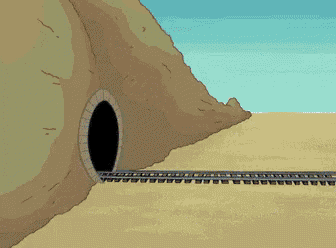Can’t think of a better community to ask.

There are double decker subway trains in Sydney, Australia
So that’s a subway and not a commuter train? Hard to tell.
It’s both. They’re the same trains in Sydney. It’s mostly an overground network with several underground parts in the city centre
This style was commissioned starting in the 70’s, when population density was lower, there were fewer trains, and average travel time was higher due to suburban sprawl and most workers employed in the inner city; many spent 1 hour or more on the train each way.
There’s a new metro project that looks more global.
Subway trains are designed to get people on and off the train as quickly as possible, with many doors and often platforms designed for quick transfers. Additionally, subways are designed for short rides, often with high stand/sit ratios.
Double decker trains are designed for long distance trips and to fit as many chairs on the train for a given train length, at the cost of number of doors and time loading/unloading passengers.
worth asking RMtransit on Mastodon, though.
You’d have to get to the right floor between stops.
Not to be too hard on RMtransit but some of this thoughts are weird.
Yeah researchers don’t always agree on things. Definitely a question up his alley though, since I think he’s done a video with a similar theme.
Actually, I just watched the new RMtransit video on YouTube, and he shows that the RER A in Paris runs double Deckers in tunnels through the center. It’s more of a commuter train, but it’s very close to a subway, and the first I’ve seen of urban commuter trains like that with double decker rolling stock.
The main downside of double-decker train cars is the time it takes passengers to to board them. And, since this is one of the main factors limiting metro frequencies and thus capacity, they’re not that suitable for subways. To maximize metro capacity, you want long trains with many doors and very high frequency.
Double-decker cars are much more suitable for lower-frequency service (S-Bahn, regional, long-distance,…) where they’re also commonly used.
Of course, you could still use double-decker cars in a metro (and maybe some places do), it’s just suboptimal.
Two level platform? Then you’re actually boarding double the number of passengers, could be useful in very busy stations.
It sounds like a weird idea at first, but maybe it could actually work. Kind-of like running two trains on top of each other instead of after each other. I guess the downside would be the need for bespoke rolling stock and larger platforms. I think, it would generally be preferable to double the frequency or run longer trains. But it could be interesting if you’ve already exhausted those.
I think cost is a problem. Cheaper is adding extra cars than boring higher tunnel.
Some trains are pretty long as it is. Your station would be unbelievably long.
The trains I take semi-regularly have a few stops with tiny station platforms, regardless of the length of the train. They will announce something like ‘if you are in the first few cars start walking back’. You better pay attention too or you’ll have to uber from the next station back to where you should’ve gotten off.
Sounds like London’s select door service. You can’t make the train too long though if it has cars that you can’t walk between because then you can’t exit at all.
There’s a balance to be made between the flow of people and the seating capacity of trains.
Single level with many doors will load/unload quickly, however there’s barely any seating. Two level maximizes seating at the expense of dwell times.Nobody made a two level train with a focus on standing yet, so we don’t have a real world example. If it’s even possible because you need more headroom than usually available on double deckers
That said there are metro-like systems with double deckers. Paris and Sydney have already been mentioned. True, they are usually classified as suburban systems, but are very much used for city trips as well.
Some subway cars in Sydney are double decked. The seats are a half floor up or down from where the doors open.
I think one of the bigger things keeping metro rolling stock from using double decker units is the need to go underground. Increased height means larger tunnels or deeper cuts and that can get cost prohibitive. This is especially the case when simply lengthening the tunneling needed for longer station boxes/platforms to support higher capacity single deck trains is less costly.
I thought this was a different community for a minute, and got really excited 😫
Hungry?
I wasn’t until I read the post 😁
As subways are usually intended for traveling short distances, the passengers have to get in and out fast. Thus, subways usually have doors in shorter distance from each other than e.g. in train trolleys, that are used on lines where the stations are in larger distance from each other than subway stations usually are. The trolleys of double decker trains have stairs close to the doors, thus the trolleys for subways would need to have equivalently more stairs. Subsequently, the space gained for passengers to sit or stand would be much less than e.g. for double decker trains.
You’d have to get up and off the second floor before your stop.
That doesn’t address anything he said.
… You are on the train. The station you want to get off is coming up soon. You stand up. You walk down the stairs. You stand at the doors. So far this is all before the station you want to get off at. When you arrive at the station you want to get off at, you walk off. That solves the getting off quickly problem. You don’t need lots and lots and lots of stairs to the point that it takes up more seating capacity than a second floor.
That scenario is assuming it’s not packed, and that there is only one person trying to do it.
Which is exactly why you didn’t address anything he said, and why this still doesn’t.
Being crushingly packed it a valid concern but yes it addresses his point. As does this: don’t sit on the top if your station is one of the first 1-2 downtown, where you can’t get down to the first floor.
You’re very adversarial for some reason so ciao.
but yes it addresses his point.
No, it doesn’t.
His entire point is that subway trains have a lot of doors, leading to a lower seat/door ratio. Your response doesn’t at all address that this ratio would change, or the actual repercussions of changing it.
In other words, you don’t know what you’re talking about, but you’re acting like you do.
You’re very adversarial for some reason so ciao.
I am matter-of-factly telling you that you’re not making a relevant point. If that’s “adversarial” to you, then you need to get your detector calibrated.
They did but they forgot to make the hole bigger and it was quite a mess
Most subway lines were dug after the city they go under was built, and, for example, there’s a whole lot of London on top of the London Underground. Very difficult to dig upwards, very expensive to dig downwards. In the above ground sections you’d have to rebuild all the road bridges.
Much easier and cheaper to run the most efficient service possible with a high throughput of trains.
I am sure someone has, but quickly realized that it would be way too expensive and have a marginal at best impact on passenger throughput, and have a big negative impact on passenger safety.
Let me explain my thoughts.
- Throughput, let make it simple, lets just double the number of people in a train, it is not realistic, but it is simple and gives the concept the benefit of the doubt. This means that the time to load and unload passengers will be increased sharply since it takes longer to get to a door, this reduces the total throughput of the system, so that you have to wait longer for the next train and wait longer for every station you stop at. But lets get to the next point to see if we can rectify this.
- Cost, double decker trains are larger than most normal trains, so you need to build larger tunnels, and if you want to build a concept where you can board at both levels at once you need to build the entire station taller and fit dedicated ramps at a minimum. The cost would be significantly higher for this concept rather than just build a longer platform and fit more cars in. Now with double the ammount of passengers getting on and off the station, we need to build larger enterances/exits with more escalators bringing up the cost again.
- Passenger safety, say that you are on the upper deck in a double decker metro train in a tunnel between stations, there is a fire and rhe train stop inside the tunnel, you are ordered to evacuate, in one scenario you are required to go down the internal stairs and evacuate on the bottom deck, this causes you to have to stand in line as others evacuate before you. In another scenario you can evacuate through all doors with ladders you place in the doors, you are about to climb down, but slip and fall, or someone knocks down the ladder, or perhaps you are the first to get to the ladder and as you try to get the ladder in place use it you accidentally hit other passengers outside already evacuating, all of this while the train is one fire and the tunnel is filling with smoke.
Single decker metro trains are enough, they bord passengers faster meaning they move faster along the system, they are less expensive giving more money to a larger system or newer trains, and they are less dangerous.
New York has some of the longest subways at 600ft (160 meters)
Next up is shanghai and Beijing.
Paris is 6th.
So we could go longer but maybe more frequent is better?
High-frequency systems with shorter trains are often more effective at moving passengers quickly during peak hours, because the trains come more often, reducing platform overcrowding and wait times. For example, the Tokyo Metro system, despite having relatively shorter trains compared to New York, serves a much higher passenger volume because of its incredibly high frequency and reliability.
What I’m thinking is double decker lets people who are going through the downtown (so cities not on the coast) to be out of the way.
No one has mentioned the idea of having double-decked stations to make it so you don’t have to worry about moving to the right floor in advance of your stop.
I would posit this as a given if we bothered to make taller tunnels for taller train-cars, but based on other comments here, I’m not sure this idea actually makes the concept of double-decker subways any more sensible or useful.
It looks like those metros that have a use for the idea have made it work in their own way and places that haven’t tend to have significant reasons of their own for not going this route. Enlarging existing tunnels vertically seems to be a non-starter in most places, for instance.
Here in Boston a lot of the commuter rail cars are double decker. I guess it’s an upgrade to carry more people rooms but a better upgrade would be running more trains. That costs money though
Like other people said, I don’t know about subway. You want to be quick on quick off. I don’t usually even sit (even when there’s room )







